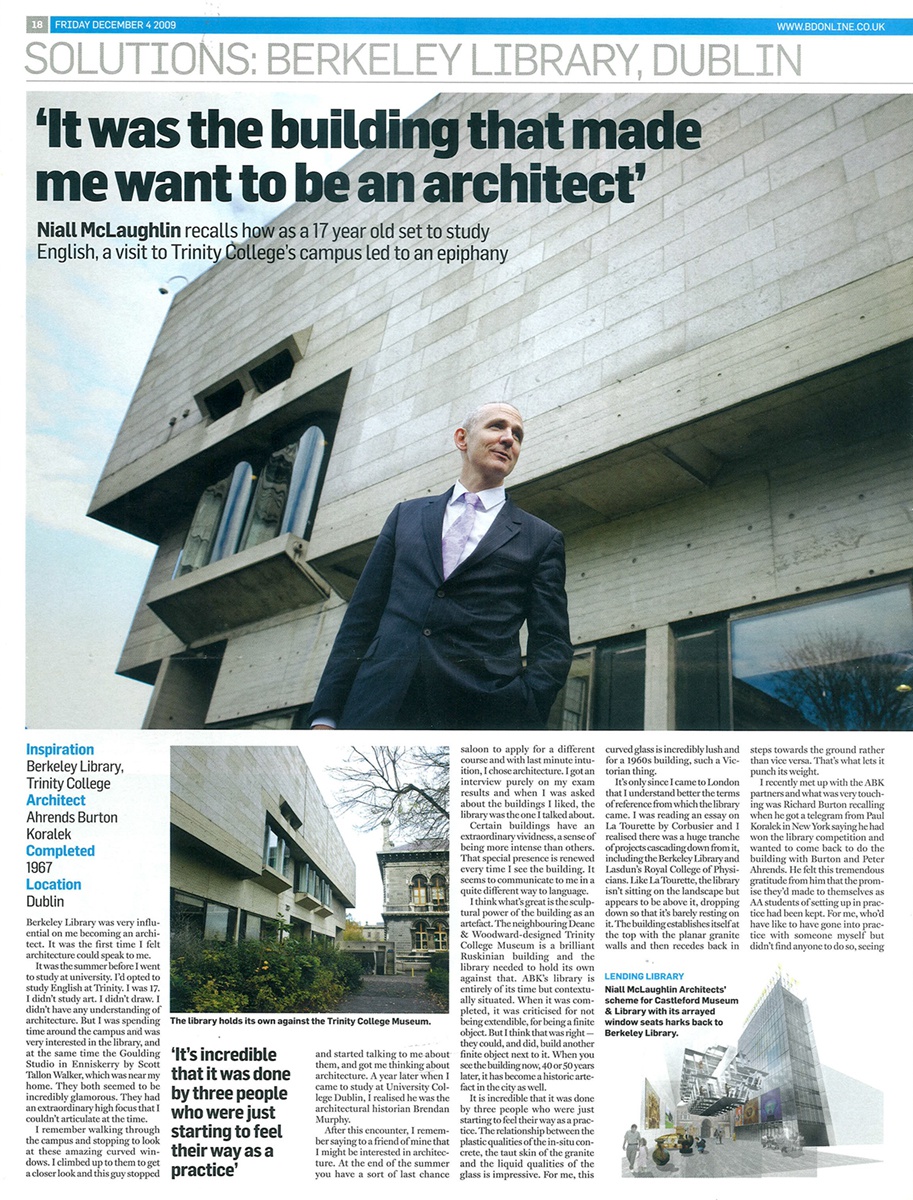Inspiration – Berkeley Library, Trinity College Dublin - Building Design
Issue 1985
January 2009
Text Pamela Buxton
Images Building Design, Níall McLaughlin Architects
Níall McLaughlin recalls how as a 17 year old set to study English, a visit to Trinity College’s campus led to an epiphany.
Berkeley Library was very influential on me becoming an architect. It was the first time I felt architecture could speak to me. It was the summer before l went to study at university. I’d opted to study English at Trinity. I was 17. I didn’t study art. I didn’t draw. I didn’t have any understanding of architecture. But I was spending time around the campus and was very interested in the library, and at the same time the Goulding Studio in Enniskerry by Scott Tallon Walker, which was near my home. They both seemed to be incredibly glamorous. They had an extraordinary high focus that I couldn’t articulate at the time.
I remember walking through the campus and stopping to look at these amazing curved windows. I climbed up to them to get a closer look and this guy stopped and started talking to me about them, and got me thinking about architecture. A year later when I came to study at University College Dublin, l realised he was the architectural historian Brendan Murphy.
After this encounter, I remember saying to a friend of mine that I might be interested in architecture. At the end of the summer you have a sort of last chance saloon to apply for a different course and with last minute intuition, I chose architecture. I got an interview purely on exam results and when I was asked about the buildings I liked, the library was the building I talked about.
Certain buildings have an extraordinary vividness, a sense of being more intense than others. That special presence is renewed every time I see the building. It seems to communicate to me in a quite different way to language.
I think what’s great is the sculptural power of the building as an artefact. The neighbouring Deane & Woodward-designed Trinity College Museum is a brilliant Ruskinian building and the library needed to hold its own against that. ABK’s library is entirely of its time but contextually situated. When it was completed, it was criticised for not being extendible, for being a finite object. But I think that was right – they could, and did, build another finite object next to it. When you see the building now, 40 or 50 years later, it has become a historic artefact in the city as well.
It is incredible that it was done by three people who were just starting to feel their way as a practice. The relationship between the plastic qualities of the in-situ concrete, the taut skin of the granite and the liquid qualities of the glass is impressive. For me, this curved glass is incredibly lush and for a 1960s building, such a Victorian thing.
It’s only since I came to London that I understand better the terms of reference from which the Library came. I was reading an essay on La Tourette by Corbusier and I realised that there was a huge tranche of projects cascading down from it, including the Berkeley Library and Lasdun’s Royal College of Physicians.
I recently met up with the ABK partners and what was very touching was Richard Burton recalling when he got a telegram from Paul Koralek in New York saying he had won the library competition and wanted to come back to do the building with Burton and Peter Ahrends, He felt this tremendous gratitude from him that the promise they’d made to themselves as AA students of setting up a practice had been kept. For me, who’d have like to have gone into practice with someone myself but didn’t find anyone to do so, seeing their pleasure in each other’s company, their generosity, and their lack of ego was great.
When I think of it, I always do back to tis confident sense of massing and also the fine details like the suppression of the window sills. I think about the exact relationship between the stone, bronze shutters and projections of glass. But I haven’t applied it literally to a project.
Perhaps the project I have designed that takes most from this experience is the competition-winning scheme for Castleford Museum & Library. The idea of taking a book from the illuminated centre and moving to a particular seat at the edge, the stepping back in of arrayed window seats and the beehivelike texture of the space are, perhaps, memories of that original experience. Sadly, my library was not built. But the Berkeley Library was the building that made me want to be an architect.
Whenever I come back to Dublin, I always pass through Trinity. For me, the library has weathered and just got better and better. The juxtaposition of its very simple surfaces with the deeply sculptured facade of its neighbour is to me still a very, very powerful architectural moment.
